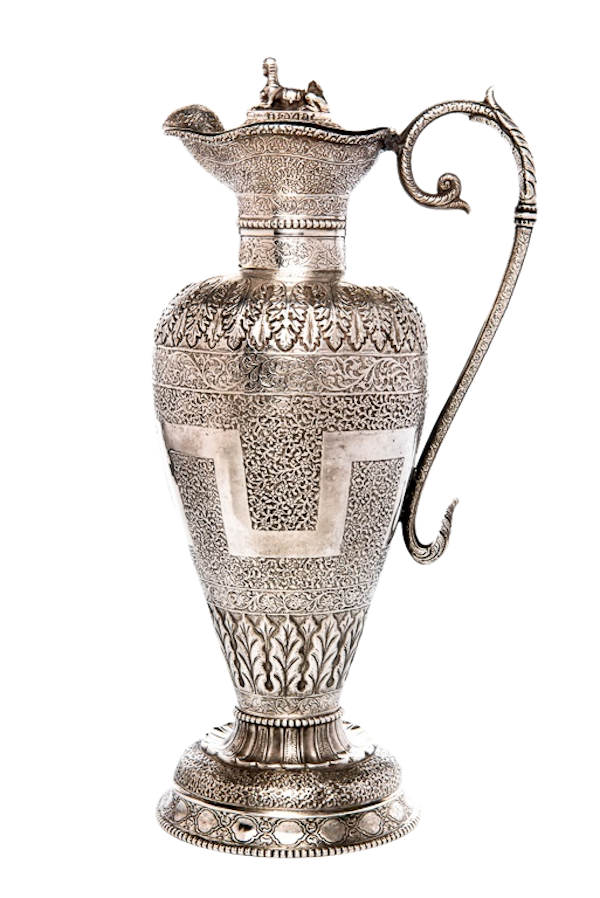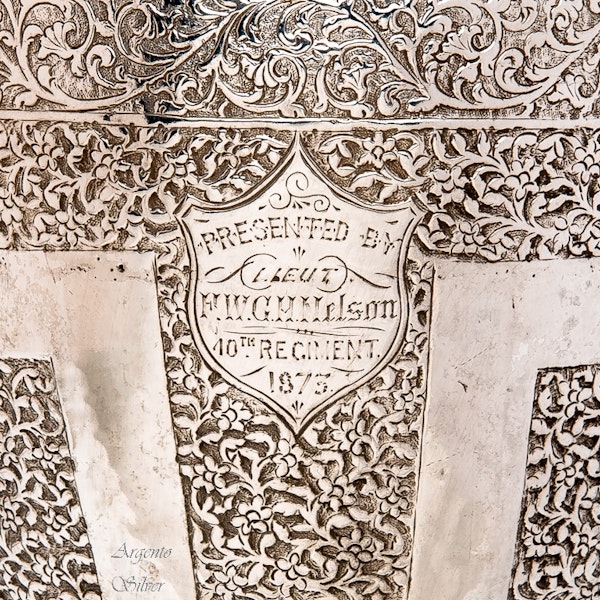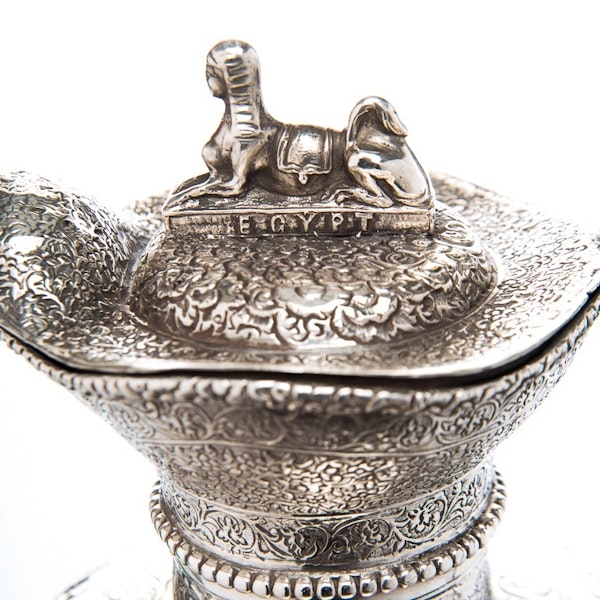ANTIQUE INDIAN SILVER REGIMENTAL JUG, MILITARY PRESENTATION, LUCKNOW, INDIA – 19TH CENTURY
ANTIQUE INDIAN SILVER REGIMENTAL JUG, MILITARY PRESENTATION, LUCKNOW, INDIA – 19TH CENTURY
£3,750.00
Description
This elegant Lucknow silver presentation jug bears the inscription “Presented by Lieut, F W G H Nelson 10th Regiment 1873”.
It is well documented that Captain Nelson served with the 40th Regiment for many years and it would appear that this jug was presented by the 40th to the 10th Regiment who was stationed alongside them, at Lucknow, in 1873. It is not known whether a new jug was specially commissioned for the presentation or, as was common at the time, whether an older and existing piece of the 40th's regimental silver was inscribed and presented. It has been suggested that the jug may have been one of a pair, with one jug retained by the 40th and the other gifted to the 10th. Gifts and exchanges of regimental silver between regiments were traditional and commonplace, particularly when the regiments were serving or stationed together.
According to ‘Stations of the British Army’, published in The Army and Navy Gazette Supplement 1882, the 10th (The Prince of Wales's Own) Royal Hussars, were also stationed in Lucknow during 1873. This was a cavalry regiment of the British Army from 1715 to 1969, when the regiment amalgamated with the 11th Hussars (Prince Albert's Own) to form The Royal Hussars (Prince of Wales's Own).
Captain F W G Hibbert Nelson is known to have served with the 40th Regiment of Foot and to have died at Dam Dam, Lower Bengal on 3rd December 1879. An extract from a later book, ‘Historical Records of the 40th (2nd Somersetshire) Regiment …’ refers to Captain Nelson and states that “He was the son of Lieutenant-General Sir A A Nelson, K.C.B., an old 40th officer, and was by other family ties intimately connected with the 40th. Before his death he collected, and had printed in pamphlet form, much interesting information regarding the early history of the regiment, which has been embodied in this record, and is referred to in the preface and elsewhere.” His name is also included in the roll of officers of the 40th, compiled in 1870.
The historical records of the 40th Regiment suggest that 1873 was a quiet year for the regiment. They state:-
‘The service companies of the regiment remained at Lucknow during the whole of 1873 – a detachment of one company being sent to Fort Machi Baun during January. On 24th March, Sir H. Tombs again inspected the regiment and was pleased to remark favourably on its general appearance and efficiency, as also upon the good conduct of the men since their arrival at Lucknow. During the hot season convalescents were sent to the depots at Naini Tal, Kasauli and Dagshai, but most of them were sufficiently recovered to rejoin the regiment before the end of the year.’
The 40th Regiment of Foot was a very distinguished infantry regiment of the British Army, formed in 1717 in Annapolis Royal, Nova Scotia. In 1881, whilst the regiment was still serving in India, it was amalgamated with the 82nd Regiment of Foot (Prince of Wales’s Volunteers) to form The Prince of Wales’s Volunteers (South Lancashire Regiment).
The finial of the jug shows the Sphinx battle honours, a Sphinx superscribed ‘Egypt’, to be displayed on Colours and badges, awarded to the 40th in 1801 by George III, in recognition of their actions in Egypt during the French Revolutionary War.
In 1801, the British mounted a successful expedition to support the Ottoman Turks and drive the French out of Egypt. The aim was to return Egypt to Turkish rule, thus preventing the French from advancing eastwards towards India and Napoleon from forming treaties with Indian rulers opposed to British India. The four flank companies of the 40th were ordered to Egypt, forming part of the reserve under the command of Major-General, later Sir John, Moore. The 40th took part in a daring assault landing in Aboukir Bay and won the admiration of the army. They later took part in the battle of Alexandria where they earned particular distinction. The army then advanced up the Nile to capture Cairo, and the campaign was concluded with the fall of Alexandria. Hostilities between France and the Ottoman Empire formally ended with the signing of the Treaty of Paris on 25 June 1802.
Provenance: UK art market
| item details | |
|---|---|
| Origin | Asian |
| Period | 19th Century |
| Style | Other |
| Condition | Excellent |
| Dimensions | Height: 35 cms, Width: 17 cms (max) |
| Diameter | Weight:1120 grams |
Product REF: 10090












